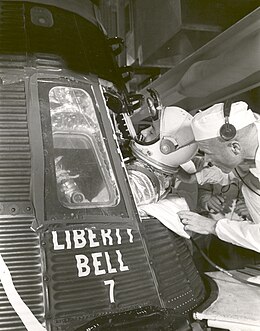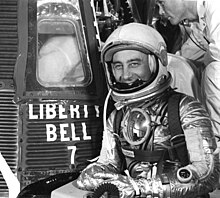Mercury-Redstone 4

Astronaut Gus Grissom climbs into Liberty Bell 7
|
|
| Mission type | Test flight |
|---|---|
| Operator | NASA |
| Mission duration | 15 minutes, 37 seconds |
| Range | 486.15 kilometers (262.50 nmi) |
| Apogee | 190.31 kilometers (102.76 nmi) |
| Spacecraft properties | |
| Spacecraft | Mercury No.11 |
| Manufacturer | McDonnell Aircraft |
| Launch mass | 1,286 kilograms (2,835 lb) |
| Crew | |
| Crew size | 1 |
| Members | Virgil I. Grissom |
| Callsign | Liberty Bell 7 |
| Start of mission | |
| Launch date | July 21, 1961, 12:20:36 UTC |
| Rocket | Redstone MRLV MR-8 |
| Launch site | Cape Canaveral LC-5 |
| End of mission | |
| Recovered by | USS Randolph |
| Landing date | July 21, 1961, 12:36:13 UTC |
| Landing site | 27°32′9″N 75°45′57″W / 27.53583°N 75.76583°W |
|
 Virgil Ivan "Gus" Grissom
Project Mercury
Manned missions |
|

Spacecraft name as painted on capsule side, with a "crack"
Mercury-Redstone 4 was the second United States human spaceflight, on July 21, 1961. The suborbital Project Mercury flight was launched with a Mercury-Redstone Launch Vehicle, MRLV-8. The spacecraft, Mercury capsule #11, was named Liberty Bell 7 and piloted by astronaut Virgil I. "Gus" Grissom.
The flight lasted 15 minutes 30 seconds, reached an altitude of more than 102.8 nautical miles (190.4 km) and traveled 262.5 nautical miles (486.2 km) downrange, landing in the Atlantic Ocean. The flight went as expected until just after splashdown, when the hatch cover, designed to release explosively in the event of an emergency, accidentally blew. Grissom was at risk of drowning, but was recovered safely. The capsule sank into the Atlantic and was not recovered until 1999.
Mercury spacecraft #11 was designated to fly the second manned suborbital flight in October, 1960. It came off McDonnell's St. Louis production line in May 1960. Spacecraft #11 was the first Mercury operational spacecraft with a centerline window instead of two portholes. It was closer to the final orbital version than was Alan Shepard's Freedom 7. Dubbed Liberty Bell 7, it featured a white, diagonal irregular paint stripe starting at the base of the capsule and extending about two-thirds toward the nose, emulating the crack in the famed Liberty Bell in Philadelphia, Pennsylvania.
Spacecraft #11 also had a new explosive hatch release. This would allow an astronaut to exit the spacecraft quickly in the event of an emergency. Emergency personnel could also trigger the explosive hatch from outside the spacecraft by pulling on an external lanyard. Both the pop-off hatch and the lanyard are standard features of ejection seats used in military aircraft, but in the Mercury design, the pilot still had to exit the craft himself, or be removed by emergency personnel. The original exit procedure was to climb out through the antenna compartment, after removing a small pressure bulkhead. This was a difficult and slow procedure. Removal of an injured or unconscious astronaut through the top hatch would be nearly impossible. The original side hatch was bolted shut with 70 bolts and covered with several spacecraft shingles, making it a slow process to open the original hatch.
...
Wikipedia
